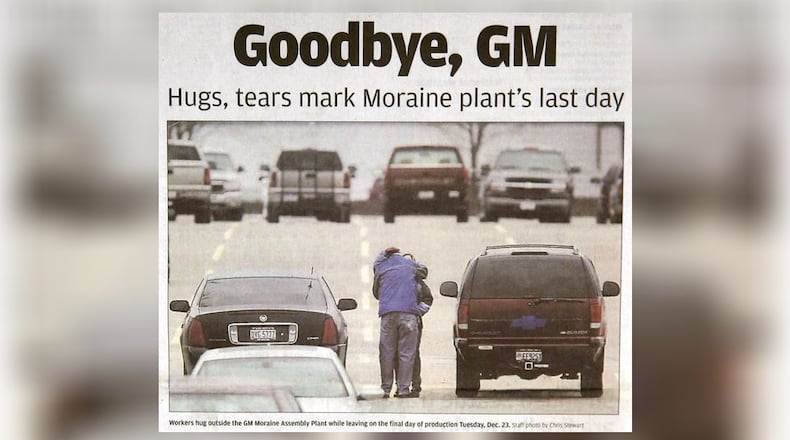The closure came six months before NCR announced it was leaving Dayton for the Atlanta area.
“Those were hard times in Dayton,” said Steve Bognar, the Yellow Springs filmmaker who made the Academy Award-nominated HBO documentary “The Last Truck: Closing of a GM Plant,” with his partner and wife Julia Reichert.
Trailblazing
On a typical eight-hour shift, GM-Moraine workers could produce more than 400 SUVs, averaging some 280,000 vehicles a year.
In its final months, the plant produced the Chevrolet TrailBlazer and TrailBlazer SS, the GMC Envoy and Envoy Denali, the Saab 9-7X and Isuzu Ascender.
GM spokespeople in 2007 and early 2008 dismissed questions about future products for the plant or about the future of the plant itself as “speculation.”
But there were distinctly dark rumblings.
In late 2007, auto industry publication Wards Auto reported that the plant would close for lack of a new SUV model to produce. The report was not attributed to a source, but it stirred long-growing fears.
Before the plant’s closure, at least once a year, maybe twice, then-Moraine City Manager Dave Hicks would travel to Detroit, often with colleagues or local leaders, talking with GM leaders, trying to build relationships and find reason for hope.
Typically, those GM officials would give Hicks little cause for optimism. But sometimes when they walked from lunch together, GM officials offered Hicks something more substantive than he got in formal meetings.
During one such post-lunch stroll, Hicks was told that every GM product at some point needed to be refreshed, replaced or retired. That was not happening with vehicles made in Moraine.
It was not what Hicks wanted to hear. But at least it was information.
“They gave me keys so that I could figure that out for myself,” the now-retired Hicks said in a new interview.
“No one was telling us the place was closing,” he added. “But they sure weren’t telling us it was going to be refreshed.”
In June 2008, Rick Wagoner, then GM’s chief executive and chairman, announced the decision: Four GM truck assembly plants would be closed, including the one in Moraine, by the end of 2010. At the time of that announcement, about 2,500 people were employed at the Moraine complex.
But the end came much sooner.
‘I knew we were in trouble’
A Frigidaire appliance plant had operated on the site from 1951 to 1979.
Local history watchers may trace the Frigidaire era to 1926 or so, when a then-young GM decided to expand and rebuild an old Dayton-Wright factory to make refrigerators.
Hicks today lives in Washington Twp. now but he still owns property in Moraine. He grew up near the Frigidaire plant and has fond memories of the complex and the people who worked there.
When Hicks started working for the city of Moraine in the 1970s as a police officer, he and others would try to avoid the plant area during shift changes because traffic became impossible to navigate.
“It was gridlock around there,” he remembered.
The number of workers at the plant varied over the years. The plant employed about 4,100 workers until mid-2006, when GM eliminated a third production shift based on slowing SUV sales — one of the first signs the plant was in trouble.
The plant was also unique, being the sole GM production site where workers were represented by the IUE-CWA union.
That wasn’t necessarily a good thing. The United Auto Workers or UAW, a much larger union, could be counted on to protect plants where it represented workers.
“I knew we were in trouble,” Hicks said. “I mean, we had the only IUE-CWA assembly plant in America. I never said that back then, but I knew that.”
When the plant closed, about 1,000 people immediately lost their jobs. And about half of Moraine’s municipal revenue vanished.
Credit: JIM NOELKER
Credit: JIM NOELKER
Today, of course, much of the complex has been remade as the home of the American arm of a Chinese-owned automobile- and safety-glass maker, Fuyao Glass America.
With some 2,000 employees, Fuyao has said it is the largest auto glass production facility in the world.
But getting to that day in May 2014 when Chinese industrialist and Fuyao Chairman Cao Dewang wrote a check for $15 million to California real estate investor Stu Lichter in a Sinclair Community College meeting room — that took some work.
“I had a great big building over there — four million-plus square feet,” Hicks said. “I wanted to be able to do something with that. And I needed the community’s support to keep that building in place.”
‘Sitting vigil’
Kate Geiger was a material group leader in the rail dock of the GM-Moraine plant on Dec. 23, 2008.
Geiger recalled bringing in parts for the final vehicle to be assembled, a white GMC Envoy, with leather heated seats and power windows. On that final day, her work had been finished for about a week.
But Geiger couldn’t tear herself away. She and others followed the parts as they were assembled into an SUV.
“We were the first ones to finish,” she said of her dock colleagues in an interview. “And then I had a lot of time on my hands. And on the last day, I pretty much followed that truck from when it came down out of the (plant) paint house to the body shop.”
It was emotional.
“I have sat with people as they’re dying from cancer,” she said. “I call it ‘sitting vigil.’ I swear to God, that’s what it felt like.”
Filmmakers Bognar and Reichert, with Wright State University film students assisting, interviewed dozens of people on that last frigid day, talking with workers in the bitter cold, filming them in Moraine bars or as they drove off the plant property to Stroop Road.
“The emotion was overwhelming,” Bognar remembered. “Everyone was crying.”
It was only gradually, in discussing the day’s footage, that the crew grasped what Bognar called “the symbolic power” of that final SUV.
The filmmakers had an image around which to coalesce — and a title for their documentary.
“I don’t know that anyone fully expected that to have the power it did,” Bognar said of that last GMC Envoy. “It just took on that power, that symbolic power, in an amazing way.”
(Reichert died from cancer in Yellow Springs about a year ago.)
‘I want you to buy this building’
In Moraine, the first order of business was keeping the plant buildings standing.
Hicks wrote President Obama, U.S. Rep. Mike Turner and others, urging them to not have the building torn down.
Turner, in a recent interview, said former Moraine Mayor Elaine Allison called him at the time, warning that “scrappers” wanted to tear the factory down.
With the Obama administration’s concurrence, Turner wrote into law a requirement in bid documents to preserve and redevelop the buildings. A reuse plan was expected of would-be owners.
“That allowed us to preserve the plant,” the congressman said.
Hicks said he understood the best way to protect the plant was to bring a new owner in.
“As far as I knew, I was the first person (from the Dayton area) to contact him,” Hicks said of his overtures to Stu Lichter.
As an investor and developer, Lichter had homes in Southern California and Nevada, but he also had a history in Ohio. His company, Industrial Realty Group (IRG), boasted a portfolio of some 50 million square feet, a lot of it in Northeast Ohio.
Hicks set Lichter in his sights. His recollection of that initial phone call is still sharp.
“I want you to buy this building,” Hicks said he told Lichter.
“You mean, you want me to look at it,” Hicks said Lichter replied.
Said Hicks: “No, Mr. Lichter, I can take my secretary out to look at it. I want you to buy it.”
‘We kept our word’
At the time, scrap prices were elevated. The RACER (Revitalizing Auto Communities Environmental Response) Trust — the bankruptcy court-created trust charged with cleaning up and, if possible, redeveloping sites GM shed in its bankruptcy stint — was getting offers for industrial sites under the pretense of development.
That did not mean development was happening.
“Ultimately the building (in some cases) would be scrapped because the scrap prices were really high,” Stu Lichter recalled in a new interview.
Lichter, after seeing the Moraine plant, determined the building’s value was greater standing.
Lichter’s Industrial Realty Group bought the site in the spring of 2011. By the summer of 2012, five small- to medium-sized companies had made a home at the plant. But by far, most of the plant remained empty.
Then in late October 2013, Moraine officials revealed in a Montgomery County application for development funds that a then-unnamed manufacturer wanted to invest $250 million at the plant, creating up to 800 jobs.
On Jan. 10, 2014, the Dayton Daily News was the first local media to identify Fuyao as the company planning to create jobs at the plant.
“Ultimately we ended up with the property,” Lichter said. “We kept our word to bring jobs and create a good thing there.”
Credit: JIM NOELKER
Credit: JIM NOELKER
‘A big chunk of my life’
Geiger attended Sinclair Community College and worked in graphic design after GM. Today, she supports her husband’s business, teaching across the Eastern half of the country “living history” as a reenactor of the Revolutionary and Seven Years wars.
Geiger grieved the loss of her GM job, but as painful as the experience was, she felt the closing of the plant opened doors for her.
“The Last Truck” documentary was nominated for an Academy Award. As a worker featured in the film, Geiger found herself staying at a Beverly Hills hotel, taking photos on a Santa Monica pier, taking part in panel discussions in New York City and more.
“It was a whirlwind,” Geiger said.
Geiger discovered a love of travel and interior design. She has traveled to Mexico, Ireland and Scotland in the last four years. She separated herself from the idea that working in one place for 40 hours a week is the only way to live.
“I lived in this little bubble of security,” she said. “I had the little home, and a little car and little job that I would go to, and that was my life.”
Now, she says: “I love to travel. I love to create. And I never knew that about myself.”
1919: General Motors buys the Dayton Wright Airplane Co. for its Frigidaire division.
1950: Construction starts on modern Moraine Frigidaire/GM plant.
1981-89: Plant produces Chevrolet S-10.
1990: SUV production begins.
January 2007: Plant hails six millionth vehicle produced.
December 2007: Auto industry publication Wards Auto reports that the General Motors plant in Moraine will close for lack of a new SUV model to produce. The report is not attributed to any source, but it stirs long-growing fears that the plant is in danger. A GM spokesman says no decision has been made regarding the plant’s future.
June 3, 2008: GM CEO Rick Wagoner announces the planned closure of four truck and SUV assembly plants, including Moraine, citing economic pressures, consumer choices and gas prices.
Dec. 23, 2008: The last SUV, a GMC Envoy, rolls off the assembly line in Moraine. The plant is open for just one shift that day, and 1,100 workers are left jobless by the plant closure. At its peak, 4,300 people worked at GM-Moraine.
June 2009: GM begins a six-week stint in Chapter 11 bankruptcy protection. GM had 92,000 U.S. employees in early 2009. Today, GM claims it has more than 90,000 U.S. employees.
About the Author






